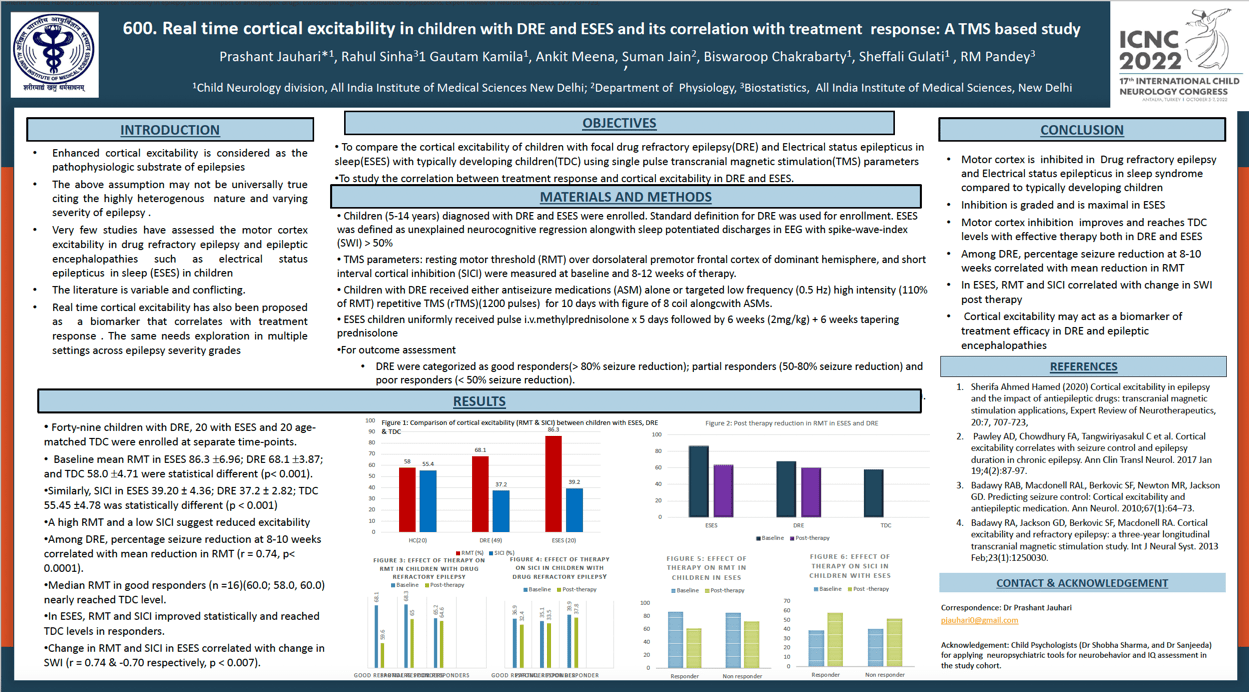Real-time cortical excitability in children with DRE and ESES and its correlation with treatment response: A TMS based comparative study
Prashant Jauhari, Rahul Sinha, Gautam Kamila, Ankit Meena, Suman Jain, Biswaroop Chakrabarty, Ravindra Mohan Pandey, Sheffali Gulati
Objective: To compare the cortical excitability of children with focal drug refractory epilepsy(DRE) and Electrical status epilepticus in sleep(ESES) with healthy controls(HC) using transcranial magnetic stimulation(TMS) parameters and to study its correlation with treatment response.
Methods: Children (5-14 years) diagnosed with DRE and ESES were enrolled. TMS parameters: resting motor threshold(RMT) over left dorsolateral prefrontal cortex, and short interval cortical inhibition (SICI) were measured at baseline and 8-12 weeks of therapy. Children with DRE received either antiseizure medications (ASM) alone or repetitive TMS (rTMS) alongwith ASMs. ESES children uniformly received steroids. For outcome assessment DRE were categorized as good responders(> 80% seizure reduction); partial responders (50-80% seizure reduction) and poor responders (< 50% seizure reduction). ESES was categorized as responders (>50% reduction in spike-wave-index (SWI) in sleep EEG) and non-responders(<50% reduction in SWI).
Result: Forty-nine children with DRE, 20 with ESES and 20 age-matched HC were enrolled. Baseline mean RMT in ESES 86.3 6.96; DRE 66.5 3.87; and HC 50.0 4.71 were statistical different (p< 0.001) (Figure1). Among DRE, seizure reduction at 8-10 weeks correlated with reduction in RMT (r=0.74, p<0.0001). Good responders(n =16) had significant reduction in RMT(p,0.001) (Figure2). Change in RMT and SICI in ESES correlated with change in SWI (r=0.74 & -0.70 respectively, p< 0.007). In ESES, RMT reduced by 29.7%±8.69 and SICI increased by 49.4%±15.3 in responders(n=15) compared to 16%±8.3, 27.1%±9.0 (p<0.0064) in non-responders(n=05).
Conclusion: Motor cortex is remotely inhibited in a graded manner in DRE and ESES compared to HCs. Effective therapy lifts this inhibition.
Keywords: Cortical excitability; Transcranial magnetic stimulation; childhood epilepsy; epileptic encephalopathy
Prashant Jauhari
All India Institute of Medical Sciences
India
Rahul Sinha
Command Hospital
India
Gautam Kamila
All India Institute of Medical Sciences
India
Ankit Meena
All India Institute of Medical Sciences
India
Suman Jain
All India Institute of Medical Sciences
India
Biswaroop Chakrabarty
All India Institute of Medical Sciences
India
Ravindra Mohan Pandey
All India Institute of Medical Sciences
India
Sheffali Gulati
All India Institute of Medical Sciences
India
Objective: To compare the cortical excitability of children with focal drug refractory epilepsy(DRE) and Electrical status epilepticus in sleep(ESES) with healthy controls(HC) using transcranial magnetic stimulation(TMS) parameters and to study its correlation with treatment response.
Methods: Children (5-14 years) diagnosed with DRE and ESES were enrolled. TMS parameters: resting motor threshold(RMT) over left dorsolateral prefrontal cortex, and short interval cortical inhibition (SICI) were measured at baseline and 8-12 weeks of therapy. Children with DRE received either antiseizure medications (ASM) alone or repetitive TMS (rTMS) alongwith ASMs. ESES children uniformly received steroids. For outcome assessment DRE were categorized as good responders(> 80% seizure reduction); partial responders (50-80% seizure reduction) and poor responders (< 50% seizure reduction). ESES was categorized as responders (>50% reduction in spike-wave-index (SWI) in sleep EEG) and non-responders(<50% reduction in SWI).
Result: Forty-nine children with DRE, 20 with ESES and 20 age-matched HC were enrolled. Baseline mean RMT in ESES 86.3 6.96; DRE 66.5 3.87; and HC 50.0 4.71 were statistical different (p< 0.001) (Figure1). Among DRE, seizure reduction at 8-10 weeks correlated with reduction in RMT (r=0.74, p<0.0001). Good responders(n =16) had significant reduction in RMT(p,0.001) (Figure2). Change in RMT and SICI in ESES correlated with change in SWI (r=0.74 & -0.70 respectively, p< 0.007). In ESES, RMT reduced by 29.7%±8.69 and SICI increased by 49.4%±15.3 in responders(n=15) compared to 16%±8.3, 27.1%±9.0 (p<0.0064) in non-responders(n=05).
Conclusion: Motor cortex is remotely inhibited in a graded manner in DRE and ESES compared to HCs. Effective therapy lifts this inhibition.
Keywords: Cortical excitability; Transcranial magnetic stimulation; childhood epilepsy; epileptic encephalopathy
Prashant Jauhari
All India Institute of Medical Sciences
India
Rahul Sinha
Command Hospital
India
Gautam Kamila
All India Institute of Medical Sciences
India
Ankit Meena
All India Institute of Medical Sciences
India
Suman Jain
All India Institute of Medical Sciences
India
Biswaroop Chakrabarty
All India Institute of Medical Sciences
India
Ravindra Mohan Pandey
All India Institute of Medical Sciences
India
Sheffali Gulati
All India Institute of Medical Sciences
India

Prashant Jauhari
All India Institute of Medical Sciences India
All India Institute of Medical Sciences India